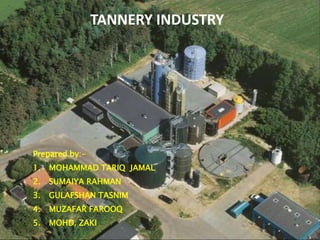
tannery industry operation, process and treatment
- 1. TANNERY INDUSTRY Prepared by:- 1. MOHAMMAD TARIQ JAMAL 2. SUMAIYA RAHMAN 3. GULAFSHAN TASNIM 4. MUZAFAR FAROOQ 5. MOHD. ZAKI
- 2. Tanning is the process that converts the protein of the raw hide or skin into a stable material which will not putrefy and is suitable for a wide variety of end applications. Tanned material dries out to a flexible form. That does not become putrid when wetted back.
- 3. Overview of the tanning industry
- 4. A typical process flow sheet in an integrated leather tannery industry
- 5. The preparatory stages are when hide/skin is prepared for tanning.Many options for pretreatment of skin exist.Not all of the options may be performed.Preparatory stages may include:- Preservation-the hide/skin is treated with a method which renders it temporarily. unputrescible. Soaking-water for purpose of washing or rehydration is reintroduced. Liming-unwanted proteins and “opening up” is achieved.
- 6. Unhairing-the majority of hair is removed. Fleshing-subcutaneous material is removed. Splitting-the hide/skin is cut into two or more horizontal layer. Reliming-the hide/skin is further treated to achieve more “opening up” or more protein removal. Deliming-liming & unhairing chemicals are removed this step. Bating-proteolytic proteins are introduced to the skin to remove further proteins and to assist with softening of the pelt.
- 7. Degreasing-natural fats/oils are stripped or as much as is possible from the hide skin. Frizing-physical removal of fat layer inside the skin. Bleaching-chemical modification of dark pigments to yield a lighter coloured pelt. Pickling-lowering of pH value to the acidic region. Must be done in presence of salt. Depickling-raising of the pH out of the acidic region.
- 9. TRIMMING.
- 12. pH 8.2-8.9 Alkalinity(mg/l) 2000-2700 Total BOD(mg/l) 2000-3100 Soluble BOD(mg/l) 1670-2600 Total COD(mg/l) 4500-7500 Soluble COD(mg/l) 25000-37000 Chlorine(mg/l) 10000-15000 Sulphates(mg/l) 1540-3300 Chromium(mg/l) 160-300
- 14. SOLIDS:-Solids to be found in tannery effluent fall into several distinct categories:- SUSPENDED SOLIDS:-Quality of insoluble matter contained in waste water. SETTELEABLE SOLIDS:-Quantity of solids, having tandency of settle down. GROSS SOLIDS:-They are larger than a sampling machine can handle. ex-leather pieces,fleshing residue.
- 15. BOD:-Tanning waste have a long break down period,this longer digestion periods can apply to a variety of chemicals used in manufacturing leather. NITROGEN:-Nitrogen is contained in several different compounds:- Total kjeldahl nitrogen:-Nitrogen contained in proteinaceous material(liming and unhairing) SULPHIDES:-Sulphide content is tannery effluent result from the use of sodium sulphide & sodium hydrosulphide.and the breakdown of hair in unhairing process.
- 16. NEUTRAL SALTS:-Two common types of salts are to be found in tannery effluent:- • Sulphates • Chlorides OIL & GREASE:-During leather manufacture, natural oils and grease are released from within the skin. pH value:-acceptable limit ranges from 5.5 to 10.0. CHROMIUM COMPOUNDS:-Two forms of chrome are associated with the tanning industry :- • Chrome 3+(trivalent chrome) • Chrome 6+(hexavalent chrome)
- 18. Most solids can be removed using simple sedimentation techniques with the solids recovered as slurry or sludge. Very fine solids and solids with densities close to the density of water pose special problems. In such case filtration may be required. Although flocculation may be used, using alum salts or the addition of polyelectrolysis.
- 20. Biodegradable organics material of plant or animal origin is usually possible to treat using extended conventional wastewater treatment processes such as activated sludge or trickling filters.
- 21. TREATMENT OF OTHER ORGANICS:- Synthetic organics material including solvents, paint, pharmaceuticals, pesticides, cooking products and so forth can be very difficult to treat. Treatment methods are often specific to the material being treated. Methods include advanced oxidation processing, distillation, adsorbtion, nitrification, incineration, chemical immobilization or landfill disposal.
- 22. TREATMENT OF ACIDS & ALKALIS: Acids & alkalis can usually be neutralised under controlled conditions. neutralization frequently produces a precipitate that will require treatment as a solid residue that may also be toxic. In some cases,gases may be evolved requiring treatment for the gas stream. Some other forms of treatment are usually required following neutralisation. OIL AND GREASE REMOVAL: Oil and grease can be recovered from open water surfaces by skimming devices.
- 23. Chromium, present in tannery effluent is removed by using chromium salts(chromium chloride as adsorbate) and cement kiln dust (a waste from white cement industry) as adsorbent. Chrome recovery plant, with a filter press
- 24. Rotating drums - for separation of hair
- 25. conclusion The treatment of tannery effluents is by now a well established technology, and modular common effluent treatment plants servicing traditional tannery clusters or newly created leather industry zones is a widely accepted approach. However, two issues still pose serious challenges: • High TDS (salinity) content, unaffected by treatment. This problem is especially pronounced in developing countries where mixing tannery effluent with domestic sewage or its discharge into the sea is not feasible, and the raw hides and skins are still preserved by salting. Relocation of tanneries to the seaside is often not feasible, and desalination of treated effluent by reverse osmosis is very expensive. • Utilization or safe disposal of sludge. Cost-effective solutions to both of these problems are still eagerly awaited.
